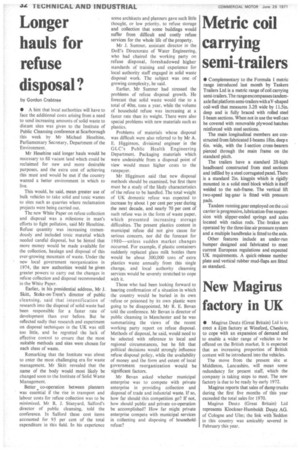Longer hauls for refuse disposal?
Page 34

If you've noticed an error in this article please click here to report it so we can fix it.
by Gordon Crabtree • A hint that local authorities will have to face the additional costs arising from a need to send increasing amounts of solid waste to distant sites was given to the Institute of Public Cleansing conference at Scarborough this week by Mr Michael Heseltine, Parliamentary Secretary, Department of the Environment.
Mr Heseltine said longer hauls would be necessary to fill vacant land which could be reclaimed for new and more desirable purposes, and the extra cost of achieving this must and would be met if the country wanted a better environment in which to live.
This would, he said, mean greater use of bulk vehicles to take solid and toxic wastes to sites such as quarries where reclamation projects were being carried out.
The new White Paper on refuse collection and disposal was a milestone in man's efforts to fight pollution, said Mr Heseltine. Refuse quantity was increasing tremendously and included toxic material which needed careful disposal, but he hinted that more money would be made available for the collection, haulage and disposal of this ever-growing mountain of waste. Under the new local government reorganization in 1974, the new authorities would be given greater powers to carry out the changes in refuse collection and disposal recommended in the White Paper.
Earlier, in his presidential address, Mr J. Skitt, Stoke-on-Trent's director of public cleansing, said that intensification of research into the disposal of solid waste had been responsible for a faster rate of development than ever before. But he reflected sadly that research and experiment on disposal techniques in the UK was still too little, and he regretted the lack of effective control to ensure that the most suitable methods and sites were chosen for each class of waste.
Remarking that the Institute was about to enter the most challenging era for waste management, Mr Skirt revealed that the name of the body would most likely be changed soon to the Institute of Solid Waste Management.
Better co-operation between planners was essential if the rise in transport and labour costs for refuse collection was to be minimized, Mr R. J. St'anyard, Salford's director of public cleansing, told the conference. In Salford these cost items accounted for 95 per cent of the total expenditure in this field. In his experience some architects and planners gave such little thought, or low priority, to refuse storage and collection that some buildings would suffer from difficult and costly refuse services for the whole life of the property.
Mr J. Sumner, assistant director in the DoE's Directorate of Water Engineering, who had chaired the working party on refuse disposal, foreshadowed higher standards of training and experience for local authority staff engaged in solid waste disposal work. The subject was one of growing complexity, he said.
Earlier, Mr Sumner had stressed the problems of refuse disposal growth. He forecast that solid waste would rise to a total of 40m. tons a year, while the volume of household refuse was increasing at a faster rate than its weight. There were also special problems with new materials such as plastics.
Problems of materials whose disposal was difficult were also referred to by Mr A. E. Higginson, divisional engineer in the GLC's Public Health Engineering Department. Packaging materials which were undesirable from a disposal point of view would mean higher costs to the ratepayer.
Mr Higginson said that new disposal methods should be examined, but first there must be a study of the likely characteristics of the refuse to be handled. The total weight of UK domestic refuse was expected to increase by about 1 per cent per year during the next decade, and nearly 70 per cent of such refuse was in the form of waste paper, which presented increasing storage difficulties. The present plastics content in municipal refuse did not give cause for serious concern, nor did the forecast for 1980—unless sudden market changes occurred. For example, if plastic containers suddenly replaced glass milk bottles there would be about 300,000 tons or extra plastics waste annually from this single change, and local authority cleansing services would be severely stretched to cope with it.
Those who had been looking forward to hearing confirmation of a situation in which the country would be buried in its own 'refuse or poisoned by its own plastic were going to be disappointed, Mr R. E. Bevan told the conference. Mr Bevan is director of public cleansing in Manchester and he was summarizing the views of the recent working party report on refuse disposal. Methods of disposal, he said, would need to be selected with reference to local and regional circumstances, but he felt that political decisions would strongly influence refuse disposal policy, while the availability of money and the form and extent of local government reorganization would be significant factors.
Mr Bevan asked whether municipal enterprise was to compete with private enterprise in providing collection and disposal of trade and industrial waste. If so, how far should this competition go? If not, how should public and private co-operation be accomplished? How far might private enterprise compete with municipal services in collecting and disposing of householdrefuse?




































































































